Health-related assessment of a vitamin and mineral supplement in school age children
Objective
Study of the effect of a vitamin-mineral complex, Vitacor Junior, on children’s health, physical development and learning performance.
Methods
Children attending the grammar school in the Zhytomyr region received one tablet daily of a vitamin-mineral complex with school meals (n = 69, the vitamin group) while children in the control group (n = 34) received only their regular school meals. Evaluation of the children was carried out before and after seven months of supplement intake.
Results
After seven months, children in the vitamin group had improved functional status of their muscular and cardiac-respiratory systems and showed a decrease in the incidence and likelihood of acute forms of illnesses. Average level of acute morbidity was decreased by 25.5 % (from 1.83 ± 0.13 to 1.37 ± 0.13 incidents per year, t = 2.44; p < 0.05) compared to the similar index before taking the supplements. The reduction of the probability of two to four acute illnesses in the year was decreased by 2.83 % (RR = 2.83; 95 % CI 1.46-5.49; EF = 64.7 %). Functional status of the cardio-respiratory systems assessed by Skibinski index was improved by 28.2 % (from 5.82 ± 0.42 to 7.46 ± 0.57, t = 2.29; p < 0.05), and diastolic blood pressure and heart rate decreased from t = -3.64; p < 0.001 to t =-2.43; p < 0.05, respectively. Functional status of the muscular system based on the indicator of the strength of hand muscles was improved by 16.2 % (t = 2.15; p <0.05) and based on evaluation of the power index (χ2 = 16.33; p < 0.01). It is established that the proportion of children with low adaptation body reserve opportunities in the control group tends to increase (y = 18.2, x – 0.1), however in the vitamin group it tends to decrease (y = -7.2, x + 49.2).
Conclusions
Daily intake of a vitamin-mineral complex contributed to the improvement of the health status of children and it should be recommended for use in children’s nutrition.
Introduction
Nutrition is the most important physiological requirement and it affects our health as well as our working capacity. It is essential for generation and constant renewal of cells and tissues, replenishment of energy, production of enzymes, hormones and other regulators of metabolic processes and vitality. A balanced diet based on scientific principles ensures preservation of our health, resistance to harmful factors in the environment, and supports longevity.
Under exposure to ecological (foreign) stress, nutrition, apart from its traditional functions, must address other aspects. These include decreasing assimilability of xenobiotics in the gastrointestinal tract, lowering harmful effects of toxic substances and factors on cellular and organism levels by limiting accumulation of xenobiotic in embryonic or growing tissues and facilitating their quick elimination from the body.
In order to accelerate the biotransformation of xenobiotics, it is necessary to provide the body with micronutrients which function as enzyme co-factors or metabolites involved in regulating various protective metabolic processes. These biologically active substances include vitamins, trace elements (iron, selenium, copper, zinc, cobalt, iodine and others), essential amino acids and others. Therefore, a well balanced diet is defined not only by its energy value in the form of proteins, fat and carbohydrates, but also by an adequate supply of micronutrients, i.e., vitamins and trace elements. All vitamins and trace elements interact with each other and it is their balance and synergy that are important for optimum cellular metabolism.
A balanced diet is one of the most important factors assuring the vitality, optimum development and overall health of children. Micronutrients (vitamins A, C, E, PP, the B group, and D) and trace elements (I, Se, Cr, Cu, Co, Zn and others) play a special role in a child’s nutrition. Lack of or long-term insufficient intake of these micronutrients has a negative effect on the physical and mental development of children affecting their growth, metabolism and increased susceptibility to illnesses.
Having studied the nutritional status of the Ukrainian population, we have found that the last decades saw a reduction in the consumption of milk and dairy products, meat, fish, and fruits and vegetables, and an increase in the consumption of bread, baked goods, pasta, pastries and sugar. All of this led to an increase in inadequate nutrition, especially in children, which is characterized by deficiencies of proteins, vitamins, and micro and macro elements. According to the data from the Institute of Paediatrics, Midwifery and Gynaecology, NAMSc of Ukraine, micronutrient deficiencies in the nutrition of primary school age children include: iodine, selenium, zinc – 42.3 %, iron – 47.6 %, manganese – 91.0 %, copper – 32.3 %, cobalt – 31.3 % and other micro elements – 25-55 % [1]. Deficiencies of protein, vitamins A, C, E, the B group, and P are also evident. These deficiencies can be compensated by supplements.
Materials and Methods
The study was carried out at Vatslavpolskaya Grammar School in the Chernoarmeyskiy district of the Zhitomirskiy region which is located 200 km from Kiev. The study protocol was developed in cooperation with the Dr. Rath Research Institute (California, USA).
The nutritional supplement used in the study was the vitamin-mineral complex (VMC), Vitacor Junior, provided by Dr. Rath Health Programs (Heerlen, The Netherlands). This supplement contains vitamins A, C, D3, B1, B2, B6, B12, niacin, folic acid, biotin, and pantothenic acid, minerals (Ca, P, Mg, and K), trace elements (Zn, Se, Cu, Mn, Cr, and Mo), amino acids (L-lysine, L-proline, L-cysteine, and L-carnitine), coenzyme Q10 and other natural components. A full list of ingredients in Vitacor Junior is presented in Table 1. The supplement was approved by the Sanitary-and-Hygienic Committee and the Ministry of Health of Ukraine (05.03.02-03/24793 from 17.03.2011). After receiving written permission from the parents, two groups of participating children were formed: the vitamin group (69 pupils), and the control group (34 pupils). During the period from 12 October 2012 to 15 May 2013, children in the vitamin group took one tablet of VMC per day at the school with lunch under supervision of their Biology teacher, and at home on weekends (Saturday, Sunday) under supervision of their parents. Study progress was recorded in the study journals kept at the school.
Table 1. Composition of nutritional supplement Vitacor Junior (VMS) contents per table
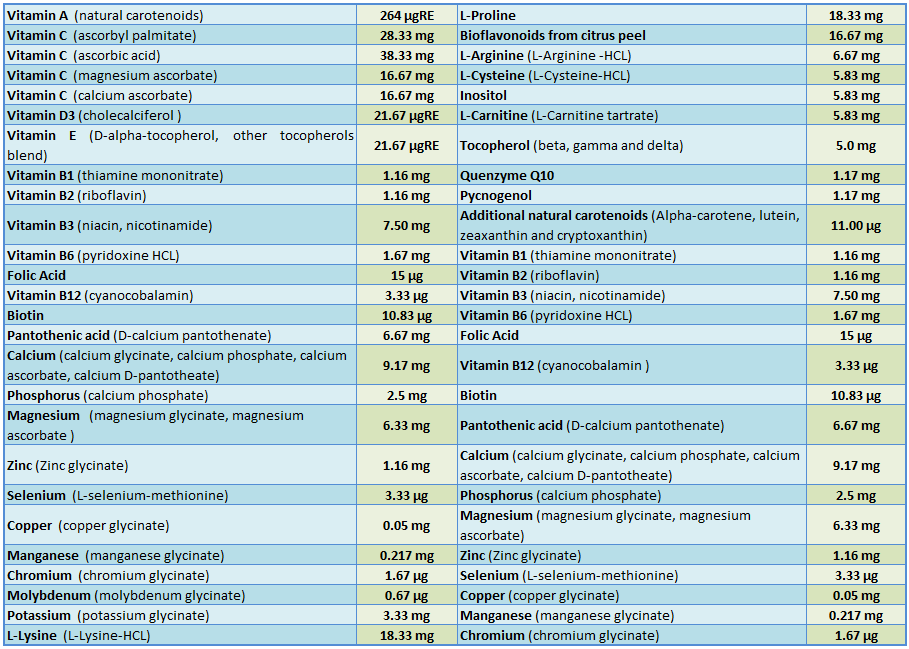
Physical and health examinations
All children underwent two physical and health examinations before taking VMC (05-12 October 2012) and seven months after taking VMC (13-17 May 2013).
Health assessments
The following health/physical assessments were conducted:

The following formula was used to determine the Ponderal Index 1 [2]:

Fitness
Fitness was assessed by Skibinsky’s circulatory-respiratory index commonly used to evaluate the efficiency of the cardio-respiratory systems [3].

The power index
The power index, which determines development of myodynamics (muscle performance) of the hand in relation to the body weight, was calculated by the formula 4 [4].

Proneness to illnesses
Proneness to illnesses, measured as number of illnesses per year, was obtained from the data in medical files. Quantitative characteristics of the effects of VMC on proneness to illness was assessed with the help of valuation of relative risk (RR) and etiological fraction (EF) [10].
General health, physical activity and emotional wellbeing of the children were assessed through personal questionnaires [5]. The CAH [6] questionnaire was used. Adaptive reserve capabilities were determined by calculating indexes of Rohrer, Robinson and Kerdo [7,8].
Statistics
Statistical data was generated with the help of STATISTICA 8.0. Classification of the material and mathematical processing were carried out using Microsoft Excel 2010. In order to assess rank data and risk calculation, contingency tables were created. Pearson’s lemma was used for studying the measure of associativity (χ2). To estimate differences between quantitative indicators, two methods of evaluation and assessment of Student’s t-test were used in accordance with formulas 5 and 6 [9]. Comparison of the results from the control group and the test group were carried out using methods for independent samples when comparing average values using formula 5:
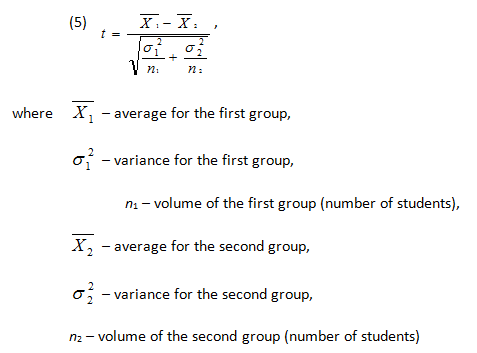
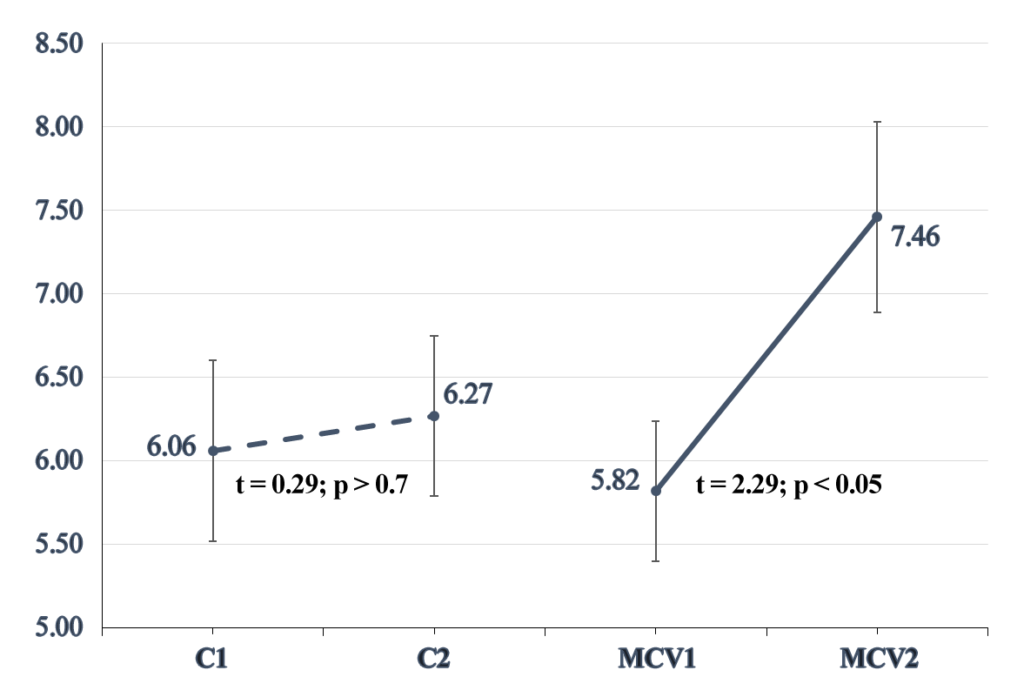
Assessment of quantitative variable difference before and after taking the VMC was carried out with the help of the Student’s t-test which is more sensitive than the traditional version of the criterion for conjugated samples {xi} and {x¢i}, which in pairs relate to the same i-object. In this research studied indicators which were registered before and after taking the VMC. Therefore, in this case the variable is the difference between indicators xi – x¢i = Di, and the Student’s test was carried out according to formula 6:
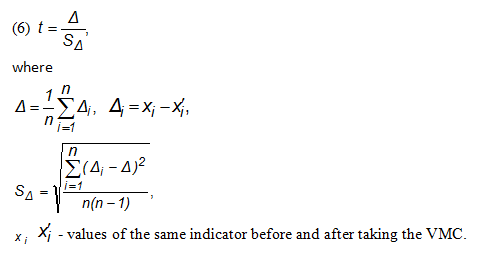
Results and Discussion
The study results showed that after seven months the average life index in the control group of children decreased by 14 %, which means the functional condition of the respiratory system worsened (t = -2.62, р < 0. 05). In the vitamin group this index did not change (р > 0.05).
Evaluation of the dynamics of morpho-functional indicators in children after seven months of supplement intake showed positive effects in the following categories: average level indicator of dynamometry of left hand increased by 16.2 % (from 18.07 to 21.05 kg t = 2.15, р < 0.05), average indicator for diastolic pressure decreased from 66.26 to 60.57 mm of mercury column ( t= -3.64, р < 0.001), and heart rate at rest decreased from 82.1 to 78.0 beats per minute, (t = -2.43, р < 0.05). The increase of the average value of Skibinsky index by 28.2 %, t= 2.29, р < 0.05 indicates an improvement of functional condition of the muscular and cardio-respiratory systems (Figure 1).
There was no statistically significant difference observed in the indicators of physical development of children (χ2 = 3.6; p > 0.7) as well as respiratory system functions (χ2 = 13.8; p > 0.3) between the vitamin and control groups over the seven-month period.
Study of the power index indicator in children in the vitamin group showed marked differences between the levels obtained before and after seven months of taking VMC (χ2 = 16.33, р < 0.003). Children in the control group have shown a tendency to feel worse (χ2 = 3.73, р > 0.444).
Susceptibility to illnesses in the children in the vitamin group over the past year, in comparison to the previous year, decreased by 25.5%: from 1.83 ± 0.13 to 1.37 ± 0.13 illnesses per year (t = -2.44, р < 005). The similar indicator in the control group showed a tendency to increase from 1.68 ± 0.17 to 1.89 ± 0.30 (t = 0.62; p > 0.5) (Figure 2). Both groups had calculated probability of two to four illnesses per year based on the calculation of relative risk (RR). The results showed that the indicators of susceptibility to illness in the control group did not change (RR = 1.0 , 95 % CI 0.55 – 1.83 , EF = 0.0 % ) maintaining two to four illnesses per year.
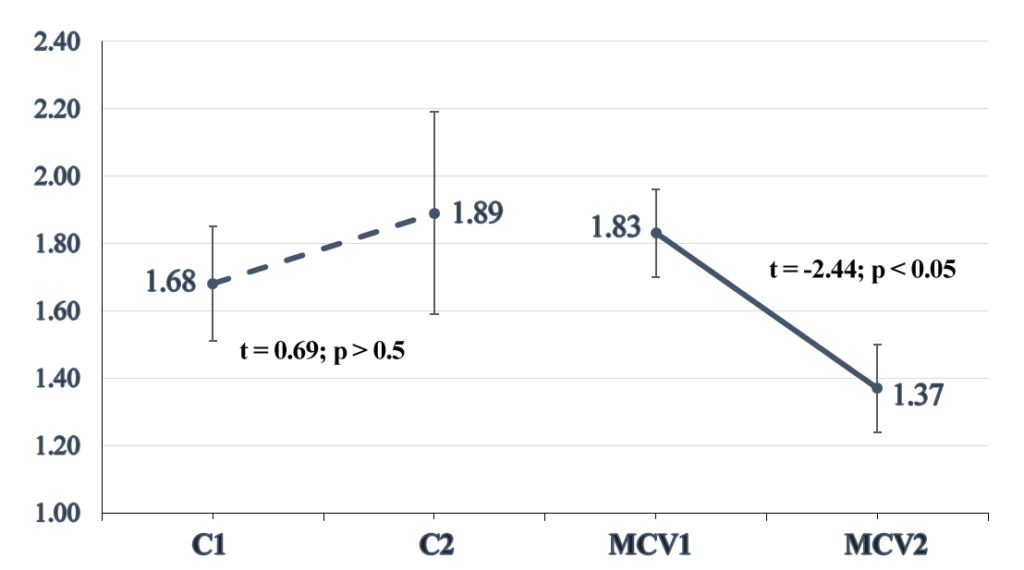
Figure 2. – Change in indicator of susceptibility to illness in children in the control group and vitamin group over tested year in comparison to the previous year (number of illnesses per year)
However, in the vitamin group this index decreased by 2,83 % (RR = 2.83 , 95 % CI 1.46 – 5.49 , EF = 64.7 %). Due to the same impact of various environmental factors on both groups of children, except for taking the MVC, it is quite likely that decreased susceptibility to illness by 64.7 % could result from the intake of the VMC. The assessment of adaptive-reserve capabilities (ARC) of children in the control and the vitamin groups showed that a number of the risk group children (children with critically low and low ARC) in the control group had a tendency to increase (y = 18.8 х – 0.1), and to decrease in the vitamin group (y = – 7.2 х + 49.2) (Table 2). The results showed that during the study the number of children with high level of ARC did not change in the control group, however it increased from 8.7 % to 14.5 % in the vitamin group as shown in the linear model (y = 5.8 х + 2.9). The evaluation of the children’s learning progress at school in both groups conducted before entering the study showed no statistically significant differences between the groups and the progress was roughly the same. However, the comparison of learning progress indicators in children in the vitamin group over the previous and current year showed that there was a statistically significant improvement in the following subjects: Ukrainian language (t = 3.32; р = 0.002), Ukrainian literature (t = 2.65; р = 0.010), music (t = 3.70; р = 0.001), physical education (t = 5.57; р = 0.001), biology (t = 2.10; р = 0,042), information science (t = 2.82; р = 0.009), and physics (t = 2.82; р = 0.009). At the same time the control groupshowed improvement in only a few subjects: Ukrainian language (t = 3.74; р = 0.001), history (t = 2.17; р = 0.037), physical education (t = 2.55; р = 0.016), and physics (t = 2.22; р = 0.041).

Table 2 – Details of the adaptive-reserve capabilities (ARC) in children in the control and the vitamin groups (%)
Conclusions
The study established that a daily intake of the VMC for seven months by a group of school age children resulted in positive shifts in several indicators of health and morpho-functional condition.
- Reduction of proneness to illnesses: Reduction of proneness to illnesses by 25.5 % (from 1.83 ± 0.13 to 1.37 ± 0.13 illnesses per year, t = 2.44; p < 0.05). The probability of illness to two to four illnesses per year decreased by 2.83 % (RR = 2.83; 95 % CI 1.46-5.49; EF = 64.7 %).
- Improvement of the functional status of the cardio-respiratory systems: Improvement of the functional status of the cardio-respiratory systems based on the indicator of the Skibinsky index by 28 % (from 5.82 ± 0.42 to 7.46 ± 0.57) (t = 2.29; p < 0,05), reduction in diastolic arterial pressure (t = -3.64; p < 0.001), reduction in heart rate at rest (t = -2.43; p < 0.05).
- Increase in the functional status of the muscular system: Increase in the functional status of the muscular system with the indicator of the muscle power of the hand increasing by 16.2 % (t = 2.15; p < 0.05) and power index (χ2 = 16.33; p < 0.01).
The study showed that a number of children with low level of ARC in the control group had a tendency to increase (y = 18.8 x – 0.1), and in the vitamin group to decrease (y = -7.2 x + 49.2). There was a tendency among the children in the control group to feel worse (y = 0.15 x + 3.53), and in the children in the vitamin group to feel better (y = 0.03 x + 3.16).
It was established that during the period of the study children in the control group showed a decrease in the average life index indicator by 14%. This criterion characterizes reserves of external respiration functions (t = -2.62; p < 0.05), and in the vitamin group this indicator stayed unchanged. The results obtained in this study allow us to recommend the VMC as a nutritional supplement to improve children’s nutrition.
Acknowledgement
The authors express huge gratitude to the director of Vatslavpolskaya Grammatheir for his important role in the organization and technical support of the project. Further, we acknowledge help of Andrey Belozub from Dr. Rath Health Programs for his excellent assistance in the implementation of this project.
References
- Kvashnina LV, Rodionov VP, Rachkovskaya VV. Macro- and microelements homeostasis and dismikroelementosis problems in childhood. Perinatology and pediatrics. 2008; 3 (35): 91-96.
- Belyakova NА, Maslov АN. Method of physical development assessment for children and youths 2271146 Russian Federation MPK А 61 В 5/107.
- Kvashnina LV, Polka NS, Kalinichenko IA, Makovkin YA. Evaluation of adaptive- and functional-reserve opportunities of an organism of school-age children: methodical recommendations. Kiev; 2010: 17.
- Apanasenko GL. Evolution of bio-energy and health. Spb.: MGP “Petropolis”; 1992: 123.
- Gozak SV, Kalinichenko IA, Stankiewicz TW, et al. The method of Evaluation of the level of motor activity in preschool children. Kiev; 2011: 6. (Information Sheet/government agency “Institute of Hygiene and Medical Ecology. Academy of Medical Sciences of Ukraine” № 42-2011).
- Raygorodskiy DY. Practical psycodiagnostics. Methods and tests. Samara: Publishing house Bakhrakh; 1998: 17-22.
- Polka NS, Gozak SV, Elizarova OT, et al. Screening assessment of adaptation and reserve capacity of preschool children: methodical recommendations (№ 10.13/101.13), Kiev; 2013: 22.
- Gozak SV, Elizarova OT, Stankiewicz TW. The method of evaluating adaptive-reserve opportunities of school-age children. Kiev; 2011: 4. (Information Sheet/government agency “Institute of Hygiene and Medical Ecology. Academy of Medical Sciences of Ukraine” № 229-2011).
- Antomonov MY. Mathematical processing and analysis of medical-biological data. / М. Y. Antomonov – К.: Ukrainian military-medical academy, 2006: 558.
- Last D. A dictionary of Epidemiology Epidemiological dictionary/Editor John М. Last. – М.: Globus, 2009: 316.
Table 1. Composition of nutritional supplement Vitacor Junior (VMS) contents per table

Table 2 – Details of the adaptive-reserve capabilities (ARC) in children in the control and the vitamin groups (%)

Figure 1. – Dynamics of average indicator values of features of the cardio-respiratory system of children representing the control and the vitamin groups.
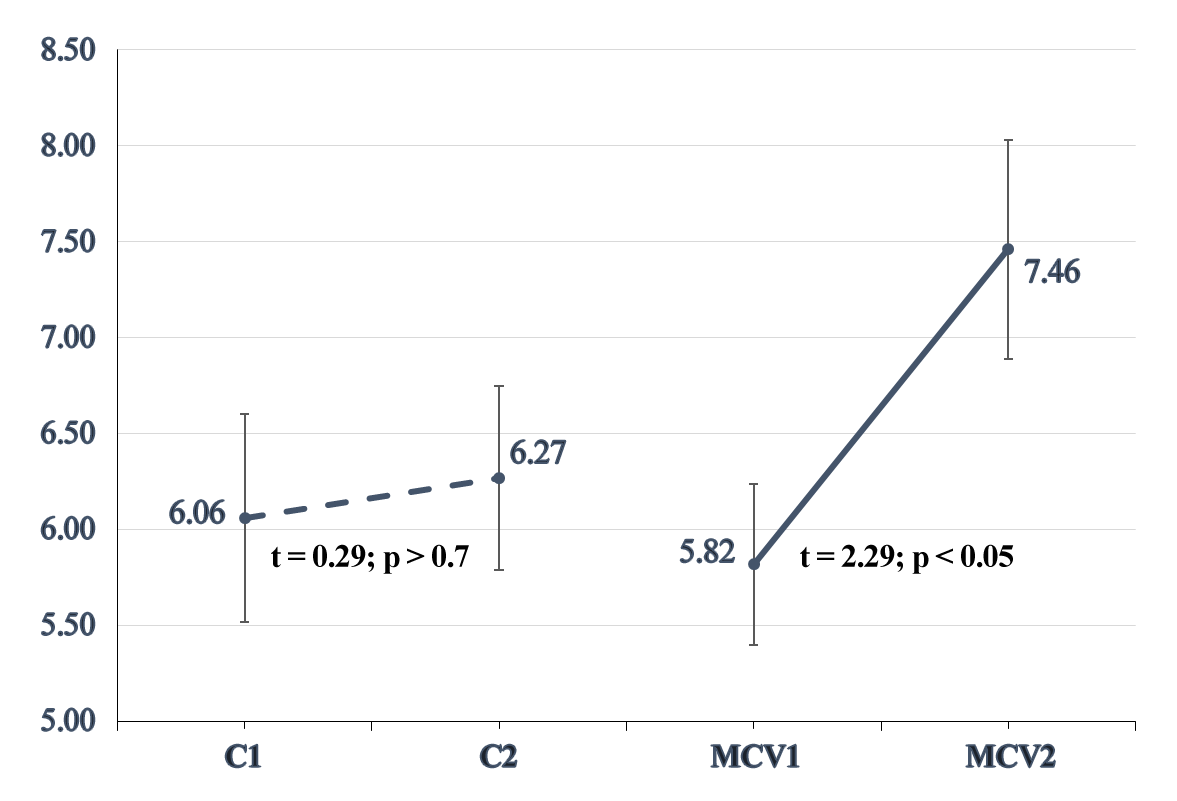
Figure 2. – Change in indicator of susceptibility to illness in children in the control group and vitamin group over tested year in comparison to the previous year (number of illnesses per year)
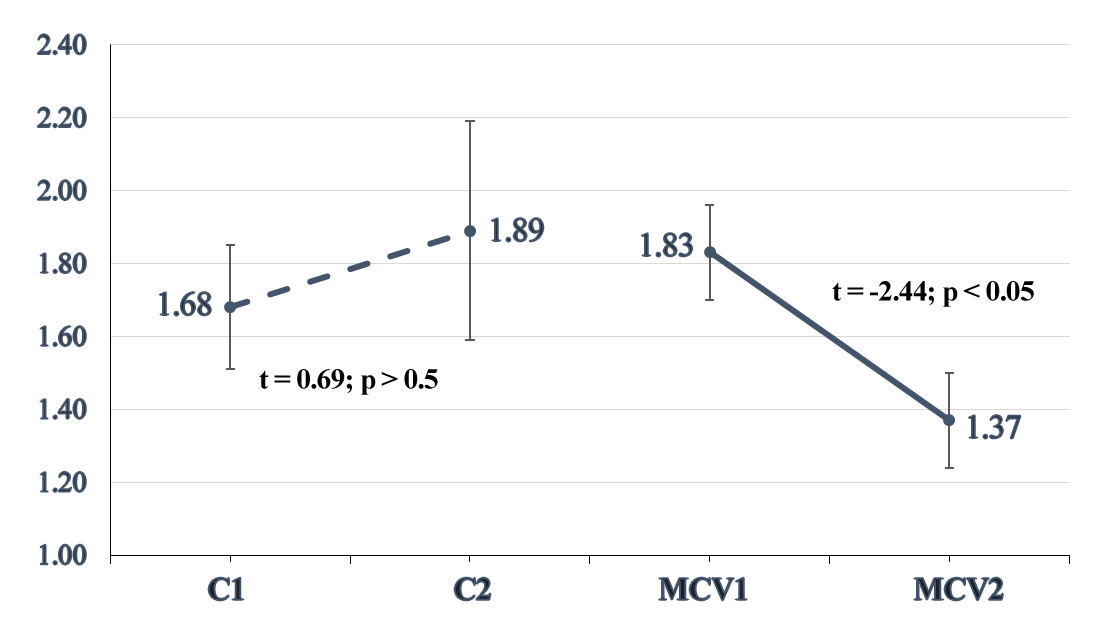
- Kvashnina LV, Rodionov VP, Rachkovskaya VV. Macro- and microelements homeostasis and dismikroelementosis problems in childhood. Perinatology and pediatrics. 2008; 3 (35): 91-96.
- Belyakova NА, Maslov АN. Method of physical development assessment for children and youths 2271146 Russian Federation MPK А 61 В 5/107.
- Kvashnina LV, Polka NS, Kalinichenko IA, Makovkin YA. Evaluation of adaptive- and functional-reserve opportunities of an organism of school-age children: methodical recommendations. Kiev; 2010: 17.
- Apanasenko GL. Evolution of bio-energy and health. Spb.: MGP “Petropolis”; 1992: 123.
- Gozak SV, Kalinichenko IA, Stankiewicz TW, et al. The method of Evaluation of the level of motor activity in preschool children. Kiev; 2011: 6. (Information Sheet/government agency “Institute of Hygiene and Medical Ecology. Academy of Medical Sciences of Ukraine” № 42-2011).
- Raygorodskiy DY. Practical psycodiagnostics. Methods and tests. Samara: Publishing house Bakhrakh; 1998: 17-22.
- Polka NS, Gozak SV, Elizarova OT, et al. Screening assessment of adaptation and reserve capacity of preschool children: methodical recommendations (№ 10.13/101.13), Kiev; 2013: 22.
- Gozak SV, Elizarova OT, Stankiewicz TW. The method of evaluating adaptive-reserve opportunities of school-age children. Kiev; 2011: 4. (Information Sheet/government agency “Institute of Hygiene and Medical Ecology. Academy of Medical Sciences of Ukraine” № 229-2011).
- Antomonov MY. Mathematical processing and analysis of medical-biological data. / М. Y. Antomonov – К.: Ukrainian military-medical academy, 2006: 558.
- Last D. A dictionary of Epidemiology Epidemiological dictionary/Editor John М. Last. – М.: Globus, 2009: 316.

